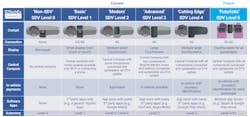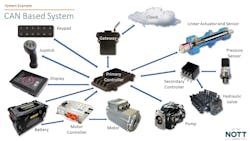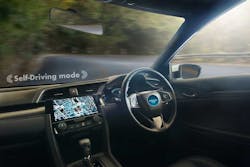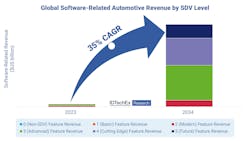How Connected and Software-Defined Vehicles are Reshaping System Architectures
Advancements in vehicle technology over the past decade have led to increased levels of connectivity and the inclusion of more software-enabled features. Much of this is driven by the desire to create more efficient and automated vehicles of all types – from passenger cars to heavy-duty trucks to construction equipment.
Research firm IDTechEx is forecasting annual revenue for connected and software-defined vehicles will be worth over $700 billion by 2034 as manufacturers continue to invest in these technologies.
Connected and software-defined vehicles (SDVs) bring opportunities for new system architectures, many of which can be simplified compared to previous designs. James Falkiner, Technology Analyst at IDTechEx, wrote in a summary of the firm’s market report on connected and SDVs that older internal combustion engine powered vehicles often included numerous components and kilometers of wiring.
However, he stated that the new era of vehicles can be more centralized, connected and convenient, bringing benefits to consumers and OEMs. For those in the fluid power and electric motion control markets serving various vehicle sectors, it is important to understand these new system architecture needs as it will influence their future designs as well.
What is a Software-Defined Vehicle?
Falkiner described SDV as that in which the software within a vehicle affects the user experience in some way. As the number of software-based features increases, the vehicle becomes more software-defined. These can include over-the-air updates, already a common feature in the trucking industry, or the ability to watch movies on the go.
A constant cellular connection is typically required for these vehicles as well as large touchscreens and a powerful central computing system which is connected to various components and systems within the vehicle.
In his summary, Falkiner noted that most vehicles introduced to the market over the past 5-10 years can be considered software-defined as they likely include some semblance of software-enabled features. During IDTechEx’s analysis of the SDV market, it gained a deeper understanding of the various types; it created an SDV Level Guide to compare the various types available to help provide a better look at current and future designs.
The guide compares software and software-critical hardware by looking at a vehicle’s connectivity level, compute power, type of displays and software systems (see figure below). With each increasing level of software-enabled capabilities comes inclusion of more advanced technologies and higher levels of connectivity.
CAN-Based Systems Enable Connectivity and Streamlined Designs
The drive toward further connectivity between systems and vehicles “is allowing us access to far more data on devices than we previously had,” said DJ O’Konek, Engineering Manager at Nott Co., during the National Fluid Power Association’s (NFPA) December 2023 Fluid Power Industrial Consortium (FPIC) quarterly technology conference focused on connected systems and machines.
Use of CAN-based systems, including for hydraulics and pneumatics, has played a key role in enabling ever higher levels of connectivity and data collection. Many components for these systems feature integrated controllers, sensors and additional products to collect data. “This has created a lot of advantages in developing streamlined systems by simplifying the wiring since you can just have the CAN wires and power wires going out to those devices and the onboard CAN controllers can manage those devices,” he explained.
This design also provides distributed intelligence throughout the system, removing reliance on a primary controller, he said. Instead, decisions on how a component or portion of the system should operate can be made locally at each device.
The increased amount of data accessibility which is possible with CAN-based systems is allowing the creation of far more efficient systems, said O’Konek. “We can monitor all [performance] parameters far closer [to the component] than we used to,” he said.
Additional safety can be built into a system as well because there are more controllers integrated into it. “We can have dedicated controls going on locally and have a redundant supervisory controller in the system,” he explained.
There is also the possibility of adding error checking to the data and monitoring the outputs of most of the controllers being used within the system to see if any faults occur when connecting to the physical devices. This helps to ensure optimized performance and action to be taken faster should an issue be detected.
Creation of intelligent devices with integrated controllers, sensors, etc., is becoming common practice within the fluid power and other vehicle component sectors. Using linear actuators as an example, O’Konek said the more intelligent options now allow monitoring of rotation, torque, displacement, current draw, and linear force. “By having access to these pieces of information, we can control the force going into that [actuator’s] operation to optimize for efficiency or to overcome specific limits,” he said.
READ MORE - Sensors and Software in Motion Control: Key Benefits to Consider
System Architectures Must Evolve to Meet Data Processing Needs
With the continued development of connected and software-defined vehicles will come the need to rethink system architectures, due in part to the vast amounts of data processed by these vehicles.
As data processing needs will greatly increase with these vehicles, Matt Via, Vice President of Sales and Marketing at HED Inc., said during the FPIC conference that OEMs will likely move toward use of zonal system architecture configurations. This will not only aid with data processing needs but also enable vehicle manufacturers to reduce the number of components required in a vehicle and thus the costs associated with producing it.
Defining Communication Protocols
As referenced throughout this article, there are various protocols used within vehicles and mobile machines to transmit data and enable the creation of smart, connected systems. Following are definitions for these protocols to help ensure a better understanding of industry terminology.
LAN = local area network, a computer network which connects computers within a limited area.
Ethernet = a wired computer networking technology that can be part of local area networks.
CANbus = controller area network used in vehicles of various types to allow communication between controllers and devices.
Typically, OEMs utilize a domain architecture in which vehicle controls are organized around functions and all inputs and outputs that are part of that function are wired back to that location he said. This requires at least four CANbuses to be used to move data across the vehicle. And as data needs continue to increase, so will the number of CANbuses.
Use of the Ethernet communication protocol instead could help meet future data processing needs without adding more components to already space-constrained vehicles. This will require a reorganization of how functions are distributed from functions to locations on the vehicle, said Via, leading to an evolution from domain to zonal architectures.
“With [this] change, an Ethernet backbone is set up around the vehicle allowing controllers to share data between them. Within each zone, LAN and CAN, which are more optimized for lower speeds and lower data rate applications, are used to collect data from sensors while zonal gateways then use the Ethernet backbone to transfer aggregated data back and forth for data processing,” he explained.
“The evolution from the domain to the zonal architecture will start with the alignment of the body domain, incorporating power distribution and central computing,” he continued. “Over time, more and more domains around the vehicle [will be] added all using the same backbone.”
Using a zonal configuration not only benefits increased data processing needs but also allows for simplification and shortening of wire harnesses, reducing space claim and production costs. Additionally, Via said that in a zonal configuration, “the software layers become more contained, allowing components to simply transfer raw data and remove multiple locations for software configurations, meaning less locations to maintain software.”
All of this can help to create more simplified vehicle architectures which reduce production costs for OEMs and potential maintenance issues for end users – fewer components mean fewer failure points.
Future Market Opportunities for SDV
IDTechEx said the software-defined vehicle market is an emerging one with many OEMs in the automotive industry determining how to proceed with monetizing the features available in these vehicles as well as how they want to enable these features.
Per IDTechEx, OEMs such as Ford, Tesla and BMW are already generating revenue from software features such as connectivity, real-time traffic information and heated steering wheels. Meanwhile, there are also automotive manufacturers still utilizing limited or sluggish onboard compute technologies and unoptimized software which is limiting the revenue potential they could see from more advanced, SVD designs.
According to Via, SVD will present revenue opportunities for OEMs in the heavy-duty equipment market as well. The ability to provide over-the-air updates in these vehicles over their lifespan will allow OEMs to build constant value for vehicles in the field, he said. The ability to fix issues with over-the-air programming can increase uptime, providing a key differentiator for early adopters of this capability.
With the amount of data collected by SVD, it will also be possible for machine manufacturers to get a better understanding of actual vehicle usage which can be used to design better machines.
“Software is the future in vehicles that will drive changes to architectures and expand how connectivity is used in the vehicle,” said Via.
He went on to say that in the future, SVD will also accelerate the pace at which data on vehicles is created, as well as the opportunities that can be created from data. It will provide OEMs with the chance to build customer value on existing vehicles, increase satisfaction, and lower warranty rates. As such, it will be important for manufacturers to focus on desired outcomes from the vast amount of data collected. “Users of data want to get an outcome that produces a better result, otherwise it’s noise and expense,” he said.
Therefore, it will be important for OEMs to utilize an outcome driven framework when developing their SVD. “Start with the outcome, not the data, and determine what is needed to deliver that outcome.”
Given the many opportunities SVD can provide automotive and heavy-duty vehicle manufacturers, IDTechEx is forecasting a 35% compound annual growth rate (CAGR) for software-related revenue through 2034.
About the Author
Sara Jensen
Executive Editor, Power & Motion
Sara Jensen is executive editor of Power & Motion, directing expanded coverage into the modern fluid power space, as well as mechatronic and smart technologies. She has over 15 years of publishing experience. Prior to Power & Motion she spent 11 years with a trade publication for engineers of heavy-duty equipment, the last 3 of which were as the editor and brand lead. Over the course of her time in the B2B industry, Sara has gained an extensive knowledge of various heavy-duty equipment industries — including construction, agriculture, mining and on-road trucks —along with the systems and market trends which impact them such as fluid power and electronic motion control technologies.
You can follow Sara and Power & Motion via the following social media handles:
X (formerly Twitter): @TechnlgyEditor and @PowerMotionTech
LinkedIn: @SaraJensen and @Power&Motion
Facebook: @PowerMotionTech

Leaders relevant to this article:






